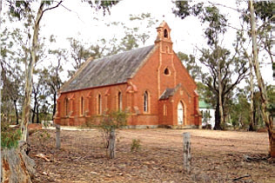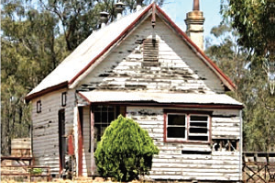Goldfields Getaway
1 March, 2021
Tarnagulla, Llanelly, Arnold and Newbridge
This tour takes in Tarnagulla, Llanelly, Arnold and Newbridge – all gold mining areas Starting in Dunolly take the Bendigo road to Tarnagulla, passing Waanyarra (also gold bearing) and starting from the Laanecoorie turn off notice the remnants of...

This tour takes in Tarnagulla, Llanelly, Arnold and Newbridge – all gold mining areas.
Starting in Dunolly take the Bendigo road to Tarnagulla, passing Waanyarra (also gold bearing) and starting from the Laanecoorie turn off notice the remnants of old mine shafts.
One kilometre from the corner (in the bush to your left) is a historic shack. After another 0.8 km turn right to a mining complex.
Note the rawness of the mine (behind a high fence) with huge piles of diggings.
Return to the main road and turn left back to Gladstone Street and turn right. Walking tracks are on either side of the street.
At Wayman Street, turn left and follow it around. Note the reservoir and reserve (oval) – to the left.
Turn right into Stanley Street to St Saviours Church of England (1864), followed by St Francis RC Church (1912) and the school.
At Victoria Street turn right with the court house (1863) on the right and the original gaol buildings on the left.
Turn right into Gladstone Street with the Uniting Church (originally the Presbyterian Church) on the right.
Continue down to Wayman Street, turn left and then left again into Commercial Road.
Continue down and note the Masonic Hotel & Lodge (right), the Post Office, hotel and a number of shops that are now mostly residences.
You will see the original two-storey bank on the corner (Colonial Bank) – note the chimney out back (furnace that melted down the nuggets for shipping).
The hotel and town hall are still in use. In behind the theatre is a great coffee shop in the resource centre.
The manned police station is on your right and behind are the remains of the magnificent Wesley Methodist Church. To its right is a mine set up (worth a look).
On the next corner is a store from the mining days, with Bells Cottage a kilometre out of town on road to Llanelly.
Lots of additional interesting places are in Tarnagulla, such as the stone cottage. Ask at the resource centre for information and copies of historic books on Sandy Creek (Tarnagulla).
At Llanelly pass the Bridgewater turn off and the grain silos and take the next turn left.
Imagine 15,000 miners in the area in around 1856. See the town hall (previously the primary school) and the remains of a building believed to be the post office before turning right and heading to Arnold, with a brick building on your left (possibly a bank) makes the offering.
The population of Llanelly (called Kangadaar), was once around 1900 but now is very few. The first gold was found to the west of Llanelly and then all around the area.
Coming into Arnold on the left is one of the early family farm homes, then opposite is a miner’s cottage, the old school building (circa 1890), St Mary’s Anglican Church (on left 1888) and the Public Hall (1889) – note the board detailing the Arnold community history.
The buildings near the corner as you turn right to Newbridge (dirt road) – to the left is the hotel and on the right-hand side is the old store.
There are no descendants of the original families left in either area, according to a long-time ex-citizen of Llanelly.
Arriving at the next bitumen road (Newbridge-Bridgewater Road) turn left to the camping reserve.
The land to the right was the Brewery Farm, a very industrious area in the mining days. It had two breweries, a flour mill and a Chinese market garden.
There is also the remains of a winery (some vines still remain with a huge mulberry tree).
This was prior to 1909 when the Laanecoorie weir broke its bank and flooded the valley.
The homestead (still in existence) was flooded up to two feet in the house. The property has undergone a number of changes before being subdivided around 20 years ago.
In earlier days it was a cattle stud for two successive owners with 20 feet of alluvial top soil across 400 plus acres (mostly under irrigation). In the centrepiece today is an olive grove.
Return back to the highway – ahead note a two-storey house – this is the original headmaster’scottage.
Turn left into the town – on the right at Raglan Street is the nursing home of the mining days. Thehotel is well worth a visit.
The store opposite is still going strong and has a small brewery plus a catering facility.
Turn right, at the next corner is a brick building being restored.
Next on the right is the original school and opposite the church (maybe Presbyterian), now private.
Continue down this road to Laanecoorie. Find the location of the first Poseidon Mines (piles of dirt on your right and left – between Poseidon and Summers or Kings Lane).
The folk story said an early settler taking his wagon across the river, at the ford, got stuck on arock – a large nugget of gold.
There were to be five Poseidon mines in this area over the years with lots of gold found.
Back to, and over, the bridge is the recreational reserve – now fully rebuilt after the last floods of 2011.
Next is the Church of England (circa 1862), the hall and the ex–parsonage (set back). This ends thetour so cheerio till next time.
John Moir
The local mine inspector (30 years ago) stated that he was supervising 26 mines in the area.
Today similar numbers operate.














